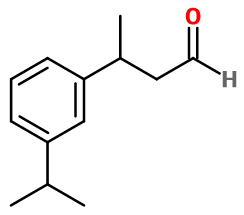
Photo credits: ScenTree SAS
| Company | Ingredient Name | ID | Comments | Naturality | Certifications | MOQ | Purity |
|---|---|---|---|---|---|---|---|
|
|
FLORHYDRAL | - |
Learn more
|
- | 10 grs | - |
General Presentation
-
CAS N° :
125109-85-5 -
EINECS number :
412-050-4 -
FEMA number :
Donnée indisponible. -
FLAVIS number :
Donnée indisponible.
-
JECFA number :
Donnée indisponible. -
Volatility :
Heart -
Price Range :
€€€
Physico-chemical properties
-
Appearance :
Colorless liquid -
Density :
0,95 -
Refractive Index @20°C :
Data not available. -
Optical rotation :
Data not available. -
Vapor pressure :
Data not available. -
Flash Point :
68°C (154,4°F)
-
Molecular formula :
C13H18O -
Molecular Weight :
190,29 g/mol -
Log P :
3,8 -
Fusion Point :
Donnée indisponible. -
Boiling Point :
257°C (494,6°F) -
Detection Threshold :
0,07 ng/l air
Chemistry & Uses
Uses in perfumery :
Florhydral® is generally used to create lily of the valley or hyacinth notes. It is especially used for reformulating Lilial®-containing perfumes. Its notes give it a good synergy with citrus notes. Used in all kinds of perfumes.
Year of discovery :
Patent N°4,910,346 (US) published on Nov. 10, 1988 by Chalk.A for Givaudan Corp.
Natural availability :
Florhydral® does not exist on a natural state. Thus, it can't be used as extracted from a plant.
Isomerism :
Florhydral® has an asymmetric carbon, giving birth to two possible enantiomers. It is anyway a blend of these two isomers that is used in perfumery. Florhydral® also is a positional isomer of Cyclamen Aldehyde, which has a relatively close smell, although more marine.
Synthesis precursor :
Florhydral® is not used for the synthesis of another molecule of olfactive interest.
Synthesis route :
Florhydral® can be synthesized by a hydroformylation reaction of 1,3-diisopropenylbenzene, using carbon monoxide and hydrogen to form an aldehydic group, starting from an alcene group.
Stability :
Stable in perfumes and in diverse functional bases, except in very acidic bases (detergents) and strong alkaline bases (liquid bleach).
Other comments :
Good synergy with Ultrazur®, with a 4:1 ratio to create beautiful ozonic and aquatic notes.
IFRA
IFRA 51th :
This ingredient is not restricted for the 51th amendment

